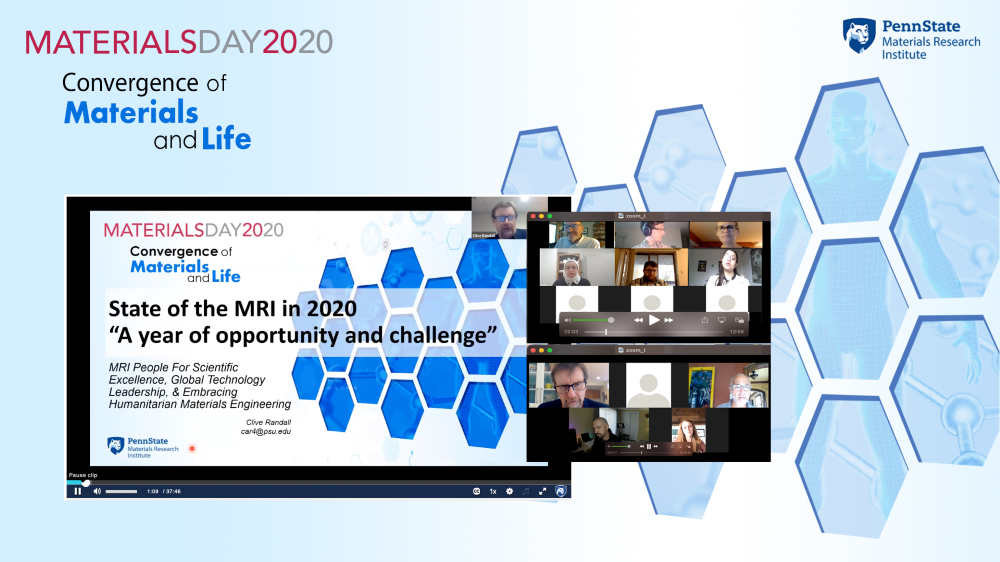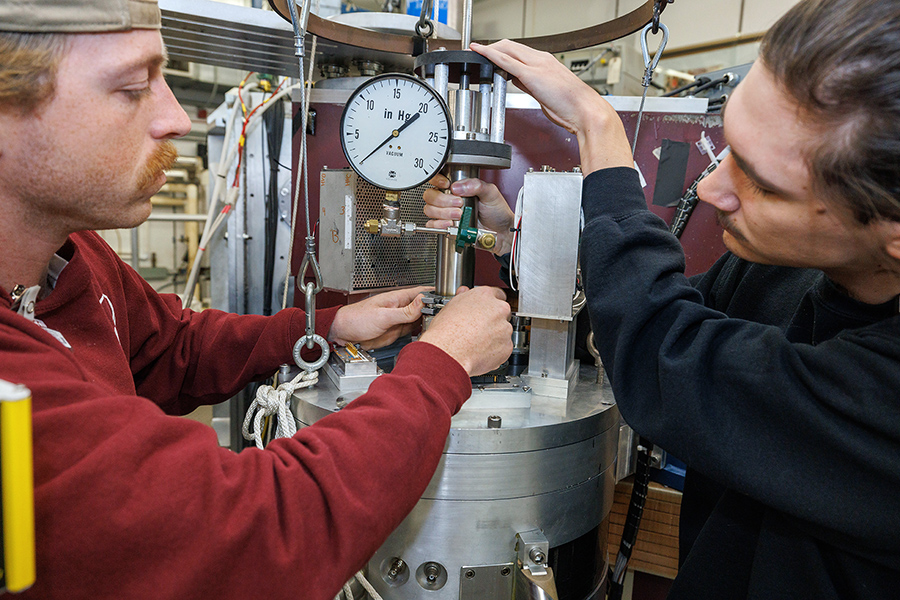The planners adjusted and despite COVID-19 preventing the usual Materials Day gathering at the Nittany Lion Inn, the virtual 2020 version, held on Nov. 11-12, attracted an event record 615 registrants. The event’s theme “Convergence of Materials and Life,” focused on how materials and devices on and inside the body will lead to better diagnostics, monitoring and therapy.
“Broad engagement with the materials community has always been germane to our planning for Materials Day,” said Clive Randall, MRI director. “We wanted this year to be a celebration of not only the great materials work being done at Penn State but also our bigger programs, including our partnership with the University of Freiburg. Despite COVID forcing our hand to a virtual event, MRI staff’s innovation and hard work allowed us to do so much in a smoothly run online version.”
An example of the in-person-to-virtual innovation was the Materials Day Flash Talks, which replaced the normal poster sessions. Instead of a room with posters and presenters discussing their work with attendees, the Flash Talks featured prerecorded brief presentations that attendees could view online. Then on both days, there were Flash Talk Q&A Sessions, each featuring different materials categories, such as Biomaterials and Medical Devices and Computer Simulation and Modeling. These sessions enabled the kind of back-and-forth discussion that makes poster sessions valuable to both presenters and attendees.
As what happens during an in-person Materials Day poster session, many attendees found that the Flash Talks gave a wide view of the breadth, depth and trends of materials research happening at Penn State.
“What I found most exciting about the materials science/engineering research on display at Materials Day is the ability to translate nature’s wisdom into new materials, which in turn help to solve global challenges in sustainability,” said Materials Day attendee Tak-Sing Wong, Wormley Family Early Career Professor of Engineering and associate professor of mechanical engineering and biomedical engineering.
Another highlight of Materials Day was a virtual State of the Materials Research Institute address given by Randall that included an unveiling MRI’s strategic plan for 2020-25, an announcement of new seed grants, and the winners of the Rustum and Della Roy Innovation in Materials Research Award.
Along with the State of the Materials Research Institute address, Materials Day also featured three keynote addresses. These included an opening Living Materials Keynote titled “Tailor-made Surfaces for the Generation of Novel Bioinspired Metamaterials – from Biochips to Hairy Surfaces” by Jürgen Rühe, director of the University of Freiburg’s Department of Microsystems Engineering and the founding director of the Freiburg Institute for Advanced Studies. This keynote focused on combining nature and technology to create materials systems that adapt autonomously to their environment and harvest clean energy from it. Also on Day 1 of the event, the NSF Program Keynote titled “Advanced Manufacturing Program & the NSF-DFG Collaboration in Advanced Manufacturing” was presented by Khershed P. Cooper, the National Science Foundation’s program director for the Division of Civil, Mechanical & Manufacturing Innovation.
After day two’s welcoming remarks by Lora Weiss, senior vice president for research at Penn State, Zoubeida Ounaies, professor of mechanical engineering and director of the new Convergence Center for Living Multifunctional Material Systems (LiMC2), presented the keynote “Living Materials: Center for Living Multifunctional Material Systems.” Ounaies’ keynote focused on how the LiMC2, in partnership with the University of Freiburg, will develop a new class of engineered living materials with multiple applications and benefits for society from infrastructure to health care.
“There were so many highlights for this event, but I especially enjoyed how the keynotes, even done virtually, did so well in reflecting the theme of living materials and the collaboration between Penn State and the University of Freiburg,” said Wong.
Other parts of the virtual Materials Day included several breakout sessions; “live” guided 3D-camera tours of MRI facilities such as the Materials Characterization Laboratory, the Nanofabrication Laboratory and the 2-Dimensional Crystal Consortium; a panel for graduate students featuring industry recruiting specialists offering job hunting strategies and tips, as well as the many different types of technical careers that can be taken in a company; breakout rooms for industry representatives to discuss potential collaborations with faculty; and prospective graduate student recruitment break out rooms for undergraduates looking to continue their materials education.
Echoing Randall’s thoughts about the event meeting its goal of building community and collaboration among materials research faculty, students and industry, Materials Day attendee Mary Frecker found that the 2020 Materials Day transcended any potential issues of doing such a program online.
“The event was a great opportunity for faculty, students and other researchers to interact with each other and with members of industry,” said Frecker, professor of mechanical engineering and biomedical engineering, the Riess Chair in Engineering at Penn State and the director of the Penn State Center for Biodevices. “This year’s theme on living materials was very timely, and I appreciated learning about the exciting research happening at Penn State and opportunities for collaboration with the University of Freiburg and others in this area.”



